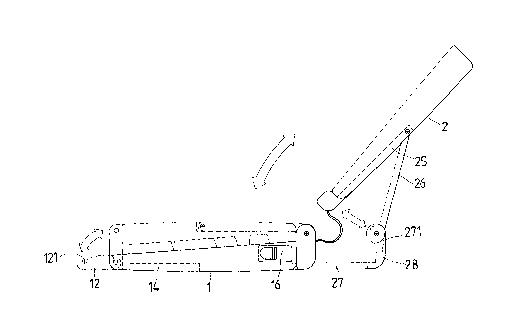Some of the information on this Web page has been provided by external sources. The Government of Canada is not responsible for the accuracy, reliability or currency of the information supplied by external sources. Users wishing to rely upon this information should consult directly with the source of the information. Content provided by external sources is not subject to official languages, privacy and accessibility requirements.
Any discrepancies in the text and image of the Claims and Abstract are due to differing posting times. Text of the Claims and Abstract are posted:
| (12) Patent: | (11) CA 2212023 |
|---|---|
| (54) English Title: | ADJUSTING DEVICE FOR A SCREEN OF A COMPUTER |
| (54) French Title: | DISPOSITIF D'AJUSTEMENT D'UN ECRAN D'ORDINATEUR |
| Status: | Expired and beyond the Period of Reversal |
| (51) International Patent Classification (IPC): |
|
|---|---|
| (72) Inventors : |
|
| (73) Owners : |
|
| (71) Applicants : |
|
| (74) Agent: | ADE & COMPANY |
| (74) Associate agent: | |
| (45) Issued: | 2000-07-18 |
| (22) Filed Date: | 1997-07-31 |
| (41) Open to Public Inspection: | 1999-01-31 |
| Examination requested: | 1997-07-31 |
| Availability of licence: | N/A |
| Dedicated to the Public: | N/A |
| (25) Language of filing: | English |
| Patent Cooperation Treaty (PCT): | No |
|---|
| (30) Application Priority Data: | None |
|---|
An adjusting device for a screen of a computer
includes a keyboard and a screen combined together with
the adjusting device for adjusting the position of the
screen from the keyboard and a sloping angle of the
screen to the keyboard to suit to different size of a
user. The device includes two support bars pivotally
connected between the screen and two bottom bars fitting
and movable in the bottom of the keyboard in a preset
distance from the keyboard. Then the dimensions of the
keyboard to sit on a table may be increased to stabilize
the computer securely. Further, the angle of the screen
to the keyboard can be adjusted by pivotal connection of
the support bars with the screen and also with the
bottom bars.
Dispositif d'ajustement d'écran d'ordinateur. Ce dernier est équipé d'un clavier et d'un écran, associés tous deux au dispositif d'ajustement pour que celui-ci ajuste la position et l'angle d'inclinaison de l'écran par rapport au clavier en les adaptant à la taille de l'utilisateur. Ce dispositif repose sur deux barres de soutien pivotantes, disposées entre l'écran et deux barres inférieures conçues pour s'emboîter et se déplacer sous le clavier, à une distance prédéterminée du clavier. On peut alors augmenter les dimensions du clavier pour l'installer sur une table en donnant une bonne stabilité à l'ordinateur. Il est également possible d'ajuster l'angle de l'écran par rapport au clavier à l'aide de barres de soutien pivotantes, disposées entre l'écran et les barres inférieures.
Note: Claims are shown in the official language in which they were submitted.
Note: Descriptions are shown in the official language in which they were submitted.

2024-08-01:As part of the Next Generation Patents (NGP) transition, the Canadian Patents Database (CPD) now contains a more detailed Event History, which replicates the Event Log of our new back-office solution.
Please note that "Inactive:" events refers to events no longer in use in our new back-office solution.
For a clearer understanding of the status of the application/patent presented on this page, the site Disclaimer , as well as the definitions for Patent , Event History , Maintenance Fee and Payment History should be consulted.
| Description | Date |
|---|---|
| Time Limit for Reversal Expired | 2001-07-31 |
| Letter Sent | 2000-07-31 |
| Grant by Issuance | 2000-07-18 |
| Inactive: Cover page published | 2000-07-17 |
| Inactive: Final fee received | 2000-04-18 |
| Pre-grant | 2000-04-18 |
| Notice of Allowance is Issued | 2000-02-18 |
| Letter Sent | 2000-02-18 |
| Notice of Allowance is Issued | 2000-02-18 |
| Inactive: Approved for allowance (AFA) | 2000-01-28 |
| Amendment Received - Voluntary Amendment | 1999-11-03 |
| Inactive: S.30(2) Rules - Examiner requisition | 1999-08-04 |
| Application Published (Open to Public Inspection) | 1999-01-31 |
| Inactive: IPC assigned | 1997-10-24 |
| Classification Modified | 1997-10-24 |
| Inactive: First IPC assigned | 1997-10-24 |
| Inactive: Filing certificate - No RFE (English) | 1997-10-09 |
| Filing Requirements Determined Compliant | 1997-10-09 |
| Application Received - Regular National | 1997-10-08 |
| Request for Examination Requirements Determined Compliant | 1997-07-31 |
| All Requirements for Examination Determined Compliant | 1997-07-31 |
There is no abandonment history.
The last payment was received on 1999-07-02
Note : If the full payment has not been received on or before the date indicated, a further fee may be required which may be one of the following
Please refer to the CIPO Patent Fees web page to see all current fee amounts.
| Fee Type | Anniversary Year | Due Date | Paid Date |
|---|---|---|---|
| Application fee - small | 1997-07-31 | ||
| Request for examination - small | 1997-07-31 | ||
| MF (application, 2nd anniv.) - small | 02 | 1999-08-02 | 1999-07-02 |
| Final fee - small | 2000-04-18 |
Note: Records showing the ownership history in alphabetical order.
| Current Owners on Record |
|---|
| JUNG-CHUAN YEN |
| Past Owners on Record |
|---|
| None |